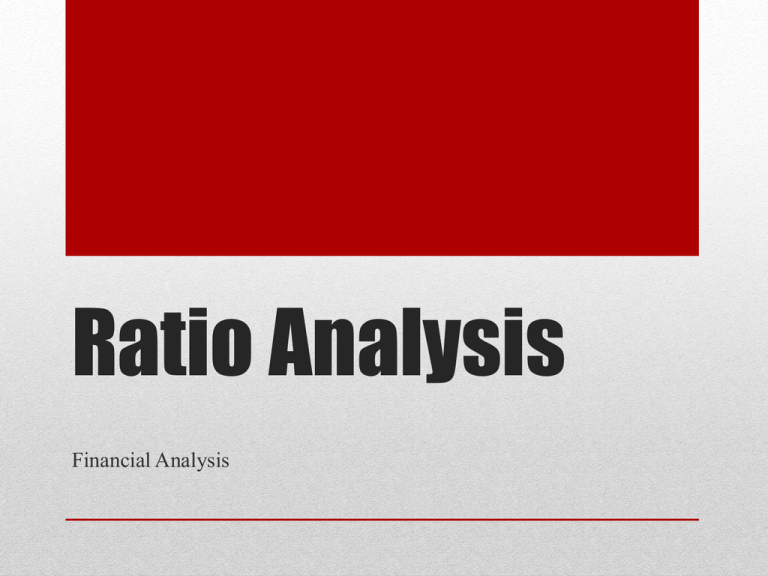
Ratio Analysis
Financial Analysis
“Copyright and Terms of Service
Copyright © Texas Education Agency. The materials found on this website are copyrighted © and trademarked ™ as
the property of the Texas Education Agency and may not be reproduced without the express written permission of the
Texas Education Agency, except under the following conditions:
1) Texas public school districts, charter schools, and Education Service Centers may reproduce and use copies of
the Materials and Related Materials for the districts’ and schools’ educational use without obtaining permission
from the Texas Education Agency;
2) Residents of the state of Texas may reproduce and use copies of the Materials and Related Materials for individual
personal use only without obtaining written permission of the Texas Education Agency;
3) Any portion reproduced must be reproduced in its entirety and remain unedited, unaltered and unchanged in any
way;
4) No monetary charge can be made for the reproduced materials or any document containing them; however, a
reasonable charge to cover only the cost of reproduction and distribution may be charged.
Private entities or persons located in Texas that are not Texas public school districts or Texas charter schools or any
entity, whether public or private, educational or non-educational, located outside the state of Texas MUST obtain
written approval from the Texas Education Agency and will be required to enter into a license agreement that may
involve the payment of a licensing fee or a royalty fee.
Call TEA Copyrights with any questions you have.
Copyright © Texas Education Agency, 2014. All rights reserved.
2
• Ratio- a comparison of two numbers
• Ratio analysis- a tool businesses use to identify possible
problems as well as opportunities
What is Ratio Analysis?
Copyright © Texas Education Agency, 2014. All rights reserved.
3
Type of Ratio
Definition
Liquidity
How well a company can pay off short-term loan
obligations and meet cash needs
Efficiency
How effectively a company utilizes its resources to
generate revenue
Leverage
Shows how a company’s assets are financed
Profitability
Measures the ability of a business’s resources to
generate income that results in a profit
Stock
Also called value or investor ratios, examines
different aspects of a company’s stock
Types of Financial Ratios
Copyright © Texas Education Agency, 2014. All rights reserved.
4
• Liquidity- measures how quickly assets can be converted
to cash
• Can determine how easily a company can meet its debt
obligations
What is Liquidity and Why
is it Important?
Copyright © Texas Education Agency, 2014. All rights reserved.
5
Ratio
Formula
Working Capital- shows
= Current Assets – Current Liabilities
what is left after all liabilities
are paid by the assets
Current Ratio- shows the
dollar value of assets for
each dollar of liabilities
= Total Current Assets/Total Current Liabilities
Quick Ratio- determines the
ability to meet short-term
debt obligations
= (Total Current Assets – Inventories)/Total
Current Liabilities
Liquidity Ratios
Copyright © Texas Education Agency, 2014. All rights reserved.
6
• Efficiency refers to how well assets and liabilities are
managed.
• These ratios are important because the focus is on
management.
What is Efficiency and
Why is it Important?
Copyright © Texas Education Agency, 2014. All rights reserved.
7
Ratio
Formula
Average collection period- how
efficiently a company’s accounts
receivables (or credit accounts) are
handled
= Average Accounts Receivable / (Total Sales / 365)
Inventory ratios- tells how often
inventory is sold; too high a ratio
can lead to high storage costs
1) Inventory turnover = Cost of Goods Sold / Average
Inventory
2) Average days to sell inventory = Days in a Year /
Inventory Turnover
Total Asset Turnover- how much a
dollar of assets generates in sales
= Sales / Average Total Assets
Accounts Receivable Turnover–
the average number of times
accounts receivable is collected in a
time period
= Sales on Account / Average Receivables
Efficiency Ratios
Copyright © Texas Education Agency, 2014. All rights reserved.
8
• Leverage is how much debt is used to finance an asset.
• It can cause a company to run the risk of bankruptcy if
there is too much debt that cannot be repaid.
What is Leverage and
Why is it Important?
Copyright © Texas Education Agency, 2014. All rights reserved.
9
Ratio
Formula
Debt to assets- measures the degree
of financing of assets
= Total Debt/Total Assets
Debt to equity- measures the amount
of debt financed by every dollar of
equity; the higher the ratio the higher
the risk to possible investors or
creditors
= Total Debt/Total Equity
Leverage Ratios
Copyright © Texas Education Agency, 2014. All rights reserved.
10
• Profitability is sales minus the costs associated with the
goods or services sold.
• Its importance is that making a profit is the most
prominent goal of most businesses.
What is Profitability and
Why is it Important?
Copyright © Texas Education Agency, 2014. All rights reserved.
11
Ratio
Formula
Net profit margin- measures
how well the cost of goods
sold is controlled, as well as
the operating expenses
= Profit after taxes / Sales
Return on investment=Net income / Owner’s Equity
represents the amount of profit
as it relates to the owner’s
investment
Return on equity– measures % = Profit after taxes / Stockholder’s Equity
of profit earned on the
stockholder’s investment
Return on assets– measures
the profit earned from the
assets of the company
= Profit after taxes / Total Assets
Profitability Ratios
Copyright © Texas Education Agency, 2014. All rights reserved.
12
• Also referred to as ratios that affect stock
• Companies raise funds by issuing stock
• Stockholders are concerned with how well a company is
performing
• Dividends are paid from profits, so stockholders are
concerned with earnings
What are Investor Ratios and
Why are they Important?
Copyright © Texas Education Agency, 2014. All rights reserved.
13
Ratio
Formula
Earnings per share– the
amount of net income that
belongs to one share of stock
= Net Income/Outstanding Shares
Price-earnings ratio–
= Current Market Price per Share / After-tax
measures the amount investors Earnings per Share
are willing to pay for every
dollar of profit
Dividend yield– measures the
return paid as dividends to
stockholders
= Annual Dividends per Share / Current Market
Price per Share
Investor Ratios
Copyright © Texas Education Agency, 2014. All rights reserved.
14
ABC Corporation
Comparative Balance Sheet
December 31, 2010 and 2011
Current Ratio = 53,500/26,000 = 2.06
Debt to Equity= 128,000/90,500 = 1.41
Ratio Demo
Copyright © Texas Education Agency, 2014. All rights reserved.
Assets
Current Assets:
Cash
Accounts Receivable
Supplies
Prepaid Insurance
Total Current Assets
Property, Plant, and Equipment:
Land
Buildings
Equipment
Total Property, Plant, and
Equipment
Total Assets
Liabilities and Stockholder’s Equity
Current Liabilities
Accounts Payable
Salaries Payable
Total Current Liabilities
Long-Term Liabilities
Mortgage Payable
Bonds Payable
Total Long-Term Liabilities
Total Liabilities
Stockholder’s Equity
Capital Stock
Retained Earnings
Total Stockholder’s Equity
Total Liabilities and Stockholder’s Equity
2011
2010
$ 7,000
39,000
3,500
4,000
$53,500
$6,500
25,000
5,000
3,700
$40,200
40,000
95,000
30,000
165,000
54,475
112,000
17,000
183,475
$218,500
$223,675
$9,000
17,000
26,000
11,300
16,500
27,800
70,000
32,000
102,000
128,000
79,100
34,175
113,275
141,075
65,000
25,500
90,500
$218,500
54,000
28,600
82,600
$223,675
15
Sunshine Corp.
2012
2011
2010
Current Ratio
2.10
1.80
2.30
Quick Ratio
1.39
1.06
1.10
Graphing Ratios
Copyright © Texas Education Agency, 2014. All rights reserved.
16
Company Comparison Chart Assignment #3 – Students will select two companies for
comparison. They will prepare a chart or table (using either a spreadsheet program or a word
Company
Comparison Chart Assignment #1 – Students will select two companies for comparison. They will prepare a
processing program) listing the five categories of ratios with two ratios each on the left side
chart
table
either athe
spreadsheet
program
or a word
processing
program).
Theycalculated
will list thefor
five
categories of ratios
andorthe
top(using
row listing
two chosen
companies
with
three years
of ratios
each.
with
twoobservation
ratios each on
the left
and the
topthe
rowyears
listingfor
theeach
two chosen
companies
threeconclusion
years of ratios calculated
One
about
theside
change
over
company
as wellwith
as one
fororeach.
One observation
about the for
change
over
the years
for each
well for
as one
or prediction must
prediction
must be included
each
ratio.
Following
is acompany
sampleas
setup
thisconclusion
chart:
be included for each ratio. Following is a sample setup for this chart:
2012
Liquidity
Current Ratio
Quick Ratio
1.30
.30
Company A
2011
1.21
.28
2010
1.12
.21
2012
1.20
.23
Company B
2011
1.26
.16
2010
1.34
.11
Ratio Gameboard Assignment #2 – In pairs, students will create a gameboard of at least 20 spaces summarizing their
understanding of ratios. There may only be five free or blank spaces. The remaining 15 should include facts and/or figures
related to ratio analysis. For example, a space could have a definition, significance, or formula for current assets. If it is
correct, the student could roll a die and move forward that many spaces. If the space has false information, the student has
to give the correct answer or roll the die and move backward that many spaces. Students can create any type of gameboard
they want as long as it is creative, entertaining, and contains at least 15 facts about ratios.
Motorola Analysis Assignment #3 – Using the website (referenced above) called, “The Case of Motorola,” the students
will each read the Financial Ratio Analysis section of the document to look for explanations of at least five different ratios.
The students will discuss the implications of what the results, whether they are higher than their industry or lower than
their industry, actually mean. For example, the Fixed Asset Turnover ratio is higher than the Semiconductor Industry ratio,
meaning that Motorola is using its assets to generate sales more resourcefully than the industry. They should include at
least five ratios in their discussion of the implications of what they mean. Students will create a one- to two-page report to
detail their findings.
Independent Practice Assignments






